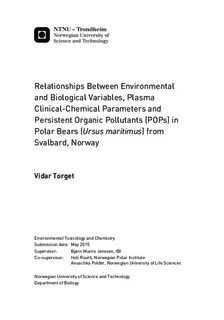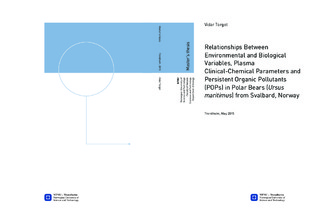| dc.description.abstract | Few previous studies have reported on levels of clinical-chemical parameters (CCPs) in polar bears (Ursus maritimus), and to date, only one study has investigated levels of CCPs and how they are related to persistent organic pollutants (POPs) in this species. The present study investigate levels of CCPs and how they vary between seasons, reproductive status, body condition (BCI) and age. In addition, the present study investigate how CCPs are related to polychlorinated biphenyls (PCBs), their hydroxylated metabolites (OH-PCBs), organochlorine pesticides (OCPs) and perfluoroalkyl substances (PFAS). This was done by analyzing plasma samples from female polar bears (n = 111) from Svalbard, Norway, sampled during spring (April) and autumn (September) in 2012 and 2013. The CCPs analyzed were: cholesterol (CHOL), high-density lipoprotein (HDLP), triglycerides (TG), aspartate aminotransferase (ASAT), alanine aminotransferase (ALAT), γ-glutamyltransferase (GGT), creatine kinase (CK), potassium (K), and the ratio of urea and creatinine (UCR). Linear mixed effect models and multivariate statistics were used to investigate the data. There were found seasonal differences for UCR, CK, TG. The lipid-related CCPs (CHOL, HDLP, TG) were positively correlated, as were the liver enzymes (ASAT, ALAT, GGT). All PFASs were inter-correlated and thus summed, as were five of eight OH-PCBs. ∑PFAS was positively correlated with each lipid-related CCP, as were several other individual POPs. ∑OH-PCB was negatively correlated with the liver enzymes. The levels of CCPs were comparable to previous studies. The seasonal difference seen in UCR supports previous studies linking UCR to fasting/feeding status. The relationships between CCPs and POPs support previous studies linking PFAS exposure to lipid metabolism. It also supports previous studies linking POPs to hepatic dysfunction. | |

